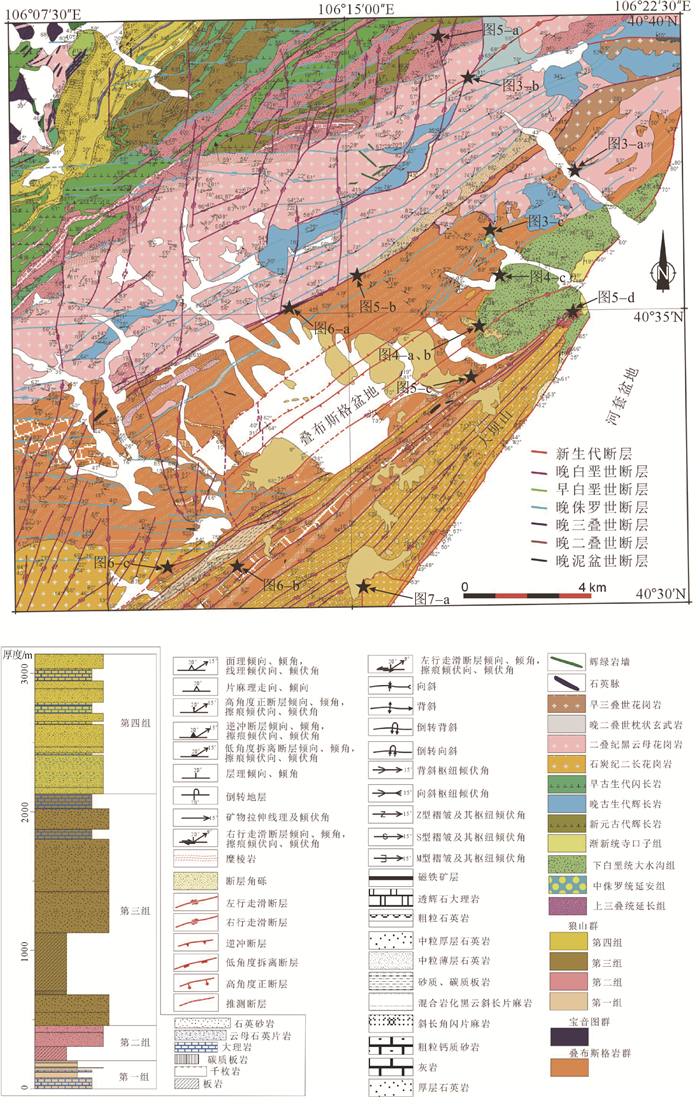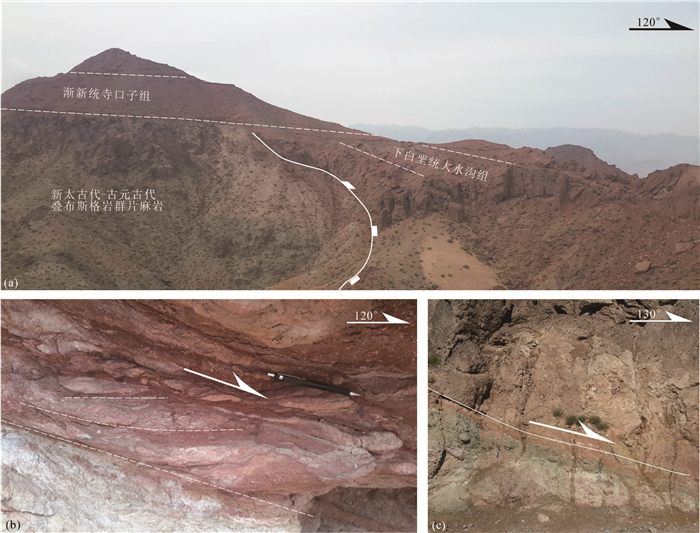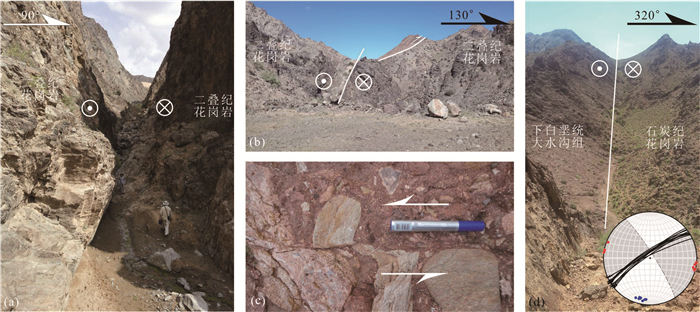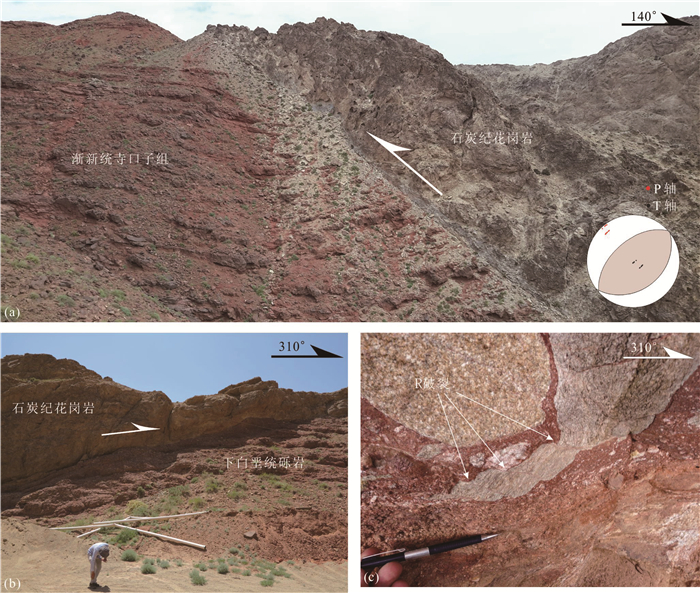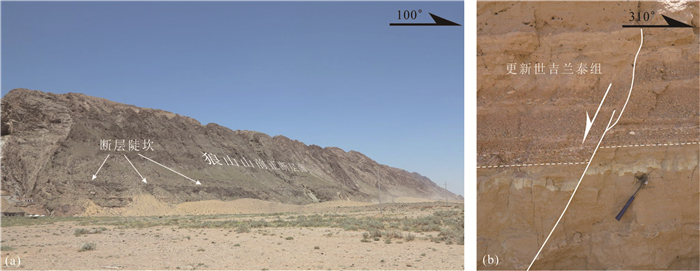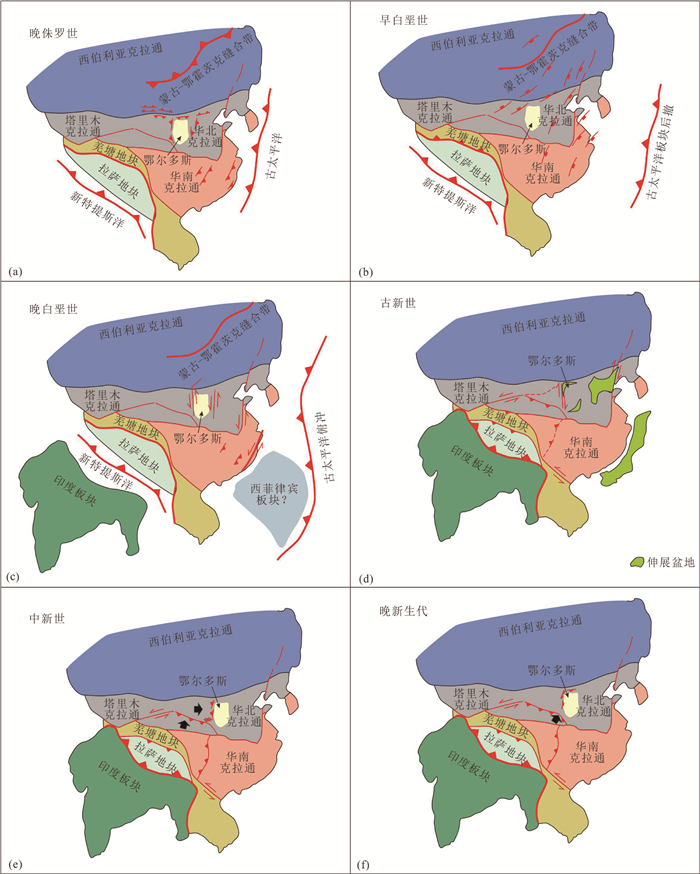Intracontinental deformation, paleo-stress field and tectonic setting in northeastern Alxa Block since Late Mesozoic
-
摘要:
陆内变形及其构造背景是地质学研究的热点之一。阿拉善地块东北缘的狼山地区中生代以来发育多期陆内变形,是研究陆内变形的理想地区。通过在狼山地区开展1:5万构造地质填图,根据大量的野外观测、详细的测量和构造切割叠加关系,结合前人所做锆石年代学和低温热年代学工作,厘定出狼山地区自晚侏罗世以来发育6期陆内变形。断层面矢量数据反演显示不同期次构造变形形成于不同的构造应力场。先存构造和欧亚板块边缘自晚侏罗世以来不同方向的增生是控制狼山地区陆内变形的主要因素。晚侏罗世—晚白垩世,狼山地区的构造变形主要受古太平洋构造域的影响,进入新生代,狼山地区开始受到青藏高原构造演化的影响。
Abstract:Intracontinental deformation and its tectonic setting is one of the hot topics of geological research. As the Langshan area in northeastern Alxa Block experienced multistage intracontinental deformations since Late Mesozoic, it is an ideal representative region to study intracontinental deformation. Based on large-scale structural mapping, detailed geological survey to clarify field cutting relationship, combined with published zircon geochronology and low-temperature thermochronology results, six stages of intracontinental deformation since the Late Jurassic in Langshan area have been determined.The vector data inversion of fault planes indicates that the deformations in different periods were formed in different paleo-stress fields. Both the previous structures and continuous accretion to the Eurasian continental margin from different directions control the tectonic evolution of Langshan area since Late Jurassic.From Late Jurassic to Late Cretaceous, the tectonic deformations of the Langshan area were mainly affected by the Paleo-Pacific tectonic domain, whereas, in Cenozoic, it began to be affected by the tectonic evolution of the Qinghai-Xizang Plateau.
-
Key words:
- Alxa Block /
- Late Mesozoic /
- Cenozoic /
- intracontinental deformation /
- paleo-stress field
-

-
图 2 狼山地区地质图(据参考文献[32]修改)及主要构造变形期次
Figure 2.
-
[1] Brown W G. Deformational style of Laramide uplifts in Wyoming foreland. Interaction of the Rocky Mountain foreland and the Coredilleran thrust belt[J]. Geological Society of America Memoir, 1988, 171: 1-25. http://www.researchgate.net/publication/278730173_Deformation_style_of_Laramide_uplifts_in_the_Wyoming_foreland
[2] Sandiford M, Hand M. Controls on the locus of intraplate deformation in central Australia[J]. Earth and Planetary Science Letters, 1998, 162(1/4): 97-110. http://adsabs.harvard.edu/abs/1998E%26PSL.162...97S
[3] Ziegler P A, Van Wees J D, Cloetingh S. Mechanical controls on collision-related compressional intraplate deformation[J]. Tectonophysics, 1998, 300(1/4): 103-129. http://www.onacademic.com/detail/journal_1000035475532610_08a3.html
[4] Raimondo T, Hand M, Collins W J. Compressional intracontinental orogens: Ancient and modern perspectives[J]. Earth-Science Reviews, 2014, 130: 128-153. doi: 10.1016/j.earscirev.2013.11.009
[5] Sengör A M C, Natal'in B A, Burtman V S. Evolution of the Altaid tectonic collage and Palaeozoic crustal growth in Eurasia[J]. Nature, 1993, 364: 299-307. doi: 10.1038/364299a0
[6] Sengör A M C, Natal'in B A. Paleotectonics of Asia: Fragments of a synthesis[C]//Yin A, Harrison T M. The tectonic evolution of Asia. New York: Cambridge University Press, 1996: 486-640.
[7] Windley B, Alexeiev D, Xiao W J, et al. Tectonic models for accretion of the Central Asian Orogenic Belt[J]. Journal of the Geological Society, London, 2007, 164: 31-47. doi: 10.1144/0016-76492006-022
[8] Xiao W J, Windley B F, Sun S, et al. A tale of amalgamation of three Permo-Triassic collage systems in Central Asia: Oroclines, sutures, and terminal accretion[J]. Annual Review of Earth and Planetary Sciences, 2015, 43: 477-507. doi: 10.1146/annurev-earth-060614-105254
[9] Lamb M A, Hanson A D, Graham S A, et al. Left-lateral sense offset of Upper Proterozoic to Paleozoic features across the Gobi Onon, Tost, and Zuunbayan faults in southern Mongolia and implications for other central Asian faults[J]. Earth and Planetary Science Letters, 1999, 173: 183-194. doi: 10.1016/S0012-821X(99)00227-7
[10] Johnson C L, Webb L E, Graham S A, et al. Sedimentary and structural records of late Mesozoic high-strain extension and strain partitioning, East Gobi basin, southern Mongolia[C]//Hendrix M S, Davis G A. Paleozoic and Mesozoic tectonic evolution of central Asia: From continental assembly to intracontinental deformation.Boulder, Colorado: Geological Society of America, 2001, 194: 413-433.
[11] Cunningham D. Folded basinal compartments of the southern mongolian borderland: a structural archive of the final consolidation of the central asian orogenic belt[J]. Geosciences, 2017, 7(1): 1-23. doi: 10.3390/geosciences7010001
[12] Darby B J, Ritts B D. Mesozoic structural architecture of the Lang Shan: North-Central China: Intraplate Contraction, Extension, and Synorogenic Sedimentation[J]. Journal of Structural Geology, 2007, 29: 2006-2016. doi: 10.1016/j.jsg.2007.06.011
[13] Zhang J, Li J Y, Li Y F, et al. Mesozoic-Cenozoic Multi-Stage Intraplate Deformation Events in the Langshan Region and their Tectonic Implications[J]. Acta Geologica Sinica, 2014, 88: 78-102. doi: 10.1111/1755-6724.12184
[14] Zhang J, Wang Y N, Qu J F, et al. Mesozoic intracontinental deformation of the Alxa Block in the middle part of Central Asian Orogenic Belt: A review[J]. International Geology Review, 2020: 1-31. doi:10.1080/00206814.2020.1783583.
[15] 牛鹏飞, 曲军峰, 张进, 等. 狼山地区叠布斯格岩群变形研究及其构造意义[J]. 地质学报, 2019, 93(8): 1867-1884. doi: 10.3969/j.issn.0001-5717.2019.08.005
[16] 赵衡, 张进, 李岩峰, 等. 内蒙古狼山地区新生代断层活动特征: 对正断层生长的限定[J]. 中国地质, 2019, 46(6): 1433-1453. https://www.cnki.com.cn/Article/CJFDTOTAL-DIZI201906014.htm
[17] 赵衡, 张进, 曲军峰, 等. 阿拉善地块东缘新生代中新世挤压变形及动力学背景[J]. 地球科学, 2020, 45(4): 1337-1361. https://www.cnki.com.cn/Article/CJFDTOTAL-DQKX202004018.htm
[18] Huang T K. On the major tectonic forms of China[J]. Geological Memoir, Ser. A, 1945, 20: 1-165. http://adsabs.harvard.edu/abs/1947JG.....55...59.
[19] 耿元生, 周喜文. 阿拉善地区新元古代岩浆事件及其地质意义[J]. 岩石矿物学杂志, 2010, 29(6): 779-795. doi: 10.3969/j.issn.1000-6524.2010.06.014
[20] 李锦轶, 张进, 曲军峰, 等. 华北与阿拉善两个古陆在早古生代晚期拼合——来自宁夏牛首山沉积岩系的证据[J]. 地质论评, 2012, 58(2): 208-214. doi: 10.3969/j.issn.0371-5736.2012.02.002
[21] Zhang J, Li J Y, Xiao W X, et al. Kinematics and geochronology of multistage ductile deformation along the eastern Alxa block, NW China: New constraints on the relationship between the North China Plate and the Alxa block[J]. Journal of Structural Geology, 2013, 57: 38-57. doi: 10.1016/j.jsg.2013.10.002
[22] Zhang J, Zhang Y P, Xiao W X, et al. Linking the Alxa Terrane to the eastern Gondwana during the Early Paleozoic: Constraints from detrital zircon U-Pb ages and Cambrian sedimentary records[J]. Gondwana Research, 2015, 28: 1168-1182. doi: 10.1016/j.gr.2014.09.012
[23] Zhang J, Zhang B H, Zhao H. Timing of amalgamation of the Alxa Block and the North China Block: Constraints based on detrital zircon U-Pb ages and sedimentologic and structural evidence[J]. Tectonophysics, 2016, 668/669: 65-81. doi: 10.1016/j.tecto.2015.12.006
[24] Yuan W, Yang Z Y. The Alashan Terrane was not part of North China by the Late Devonian: Evidence from detrital zircon U-Pb geochronology and Hf isotopes[J]. Gondwana Research, 2015, 27: 1270-1282. doi: 10.1016/j.gr.2013.12.009
[25] 李锦轶. 中国大陆地壳"镶嵌与叠覆"的结构特征及其演化[J]. 地质通报, 2004, 23(9/10): 986-1004. http://dzhtb.cgs.cn/gbc/ch/reader/view_abstract.aspx?file_no=200409174&flag=1
[26] 葛肖虹, 马文璞, 刘俊来, 等. 对中国大陆构造格架的讨论[J]. 中国地质, 2009, 36(5): 949-965. doi: 10.3969/j.issn.1000-3657.2009.05.001
[27] Yuan W, Yang Z Y. The Alashan Terrane did not amalgamate with North China block by the Late Permian: Evidence from Carboniferous and Permian paleomagnetic results[J]. Journal of Asian Earth Sciences, 2015, 104: 145-159. doi: 10.1016/j.jseaes.2014.02.010
[28] 王廷印, 王金荣, 王士政. 阿拉善北部恩格尔乌苏蛇绿混杂岩带的发现及其构造意义[J]. 兰州大学学报(自然科学版), 1992, 28(2): 194-196. doi: 10.3321/j.issn:0455-2059.1992.02.037
[29] 王廷印, 张铭杰, 王金荣, 等. 恩格尔乌苏冲断带特征及大地构造意义[J]. 地质学报, 1998, 33(4): 385-394. https://www.cnki.com.cn/Article/CJFDTOTAL-DZKX804.000.htm
[30] 吴泰然, 何国琦. 阿拉善地块北缘的蛇绿混杂岩带及其大地构造意义[J]. 现代地质, 1992, 6(3): 286-296. https://www.cnki.com.cn/Article/CJFDTOTAL-XDDZ199203005.htm
[31] Zheng R G, Wu T R, Zhang W, et al. Late Paleozoic subduction system in the northern margin of the Alxa block, Altaids: Geochronological and geochemical evidences from ophiolites[J]. Gondwana Research, 2014, 25: 842-858. doi: 10.1016/j.gr.2013.05.011
[32] 张进, 李锦轶, 刘建峰, 等. 内蒙古狼山西南地区枕状玄武岩LA-ICP-MS锆石U-Pb年龄及意义[J]. 地质通报, 2013, 32(2/3): 287-296. https://www.cnki.com.cn/Article/CJFDTOTAL-ZQYD2013Z1007.htm
[33] 田荣松, 解国爱, 张进, 等. 内蒙古狼山地区新元古代狼山群变形特征及区域构造意义[J]. 地质论评, 2018, 63(5): 1180-1192. https://www.cnki.com.cn/Article/CJFDTOTAL-DZLP201705006.htm
[34] 张北航. 阿拉善地块南缘古生代构造属性: 来自碎屑锆石年龄和变形的限定[D]. 中国地质科学院博士学位论文, 2019: 1-165.
[35] Friedmann S J, Burbank D W. Rift basins and supradetachment basins: intracontinental extensional end-members[J]. Basin Research, 1995, 7: 109-127. doi: 10.1111/j.1365-2117.1995.tb00099.x
[36] Darby B J, Ritts B D. Mesozoic contractional deformation in the middle of the Asian tectonic collage: The intraplate Western Ordos fold-thrust belt: China[J]. Earth & Planetary Science Letters, 2002, 205: 13-24. http://www.sciencedirect.com/science?_ob=ArticleURL&_udi=B6V61-478RN70-2&_user=6894003&_coverDate=12%2F30%2F2002&_rdoc=3&_fmt=high&_orig=browse&_origin=browse&_zone=rslt_list_item&_srch=doc-info(%23toc%235801%232002%23997949998%23368863%23FLA%23display%23
[37] Cui X Y, Zhao Q H, Zhang J, et al. Late cretaceous-cenozoic multi-stage denudation at the western ordos block: constraints by the apatite fission track dating on the Langshan[J]. Acta Geologica Sinica, 2018, 92: 536-555. doi: 10.1111/1755-6724.13541
[38] Rao G, Chen P, Hu J M, et al. Timing of Holocene paleo-earthquakes along the Langshan Piedmond Fault in the western Hetao Basin, North China: implications for seismic risk[J]. Tectonophysics, 2016, 677: 115-124. http://www.sciencedirect.com/science/article/pii/S0040195116300282
[39] 董树文, 张岳桥, 李海龙, 等. "燕山运动"与东亚大陆晚中生代多板块汇聚构造-纪念"燕山运动"90周年[J]. 中国科学: 地球科学, 2019, 49(6): 913-938.
[40] 郑亚东, 王士政, 王玉芳. 中蒙边界区新发现的特大型推覆构造及伸展变质核杂岩[J]. 中国科学(B辑), 1990, 12: 1299-1305. https://www.cnki.com.cn/Article/CJFDTOTAL-JBXK199012010.htm
[41] 郑亚东, Davis G A, 王琮, 等. 内蒙古大青山大型逆冲推覆构造[J]. 中国科学(D辑), 1998, 28(4): 289-295. doi: 10.3321/j.issn:1006-9267.1998.04.001
[42] Davis G A, Wang C, Zheng Y D, et al. The Enigmatic Yinshan Fold-and-Thrust Belt of Northern China: New Views on Its Intraplate Contractional Styles[J]. Geology, 1998, 26: 43-46. doi: 10.1130/0091-7613(1998)026<0043:TEYFAT>2.3.CO;2
[43] 张长厚, 张勇, 李海龙. 燕山西段及北京西山晚中生代逆冲构造格局及其地质意义[J]. 地学前缘, 2006, 13(2): 165-183. doi: 10.3321/j.issn:1005-2321.2006.02.015
[44] 张岳桥, 施炜, 廖昌珍, 等. 鄂尔多斯盆地周边断裂运动学分析与晚中生代构造应力体制转换[J]. 地质学报, 2006, 80(5): 639-647. doi: 10.3321/j.issn:0001-5717.2006.05.002
[45] 张岳桥, 董树文, 赵越, 等. 华北侏罗纪大地构造: 综评与新认识[J]. 地质学报, 2007, 81(11): 1462-1480. doi: 10.3321/j.issn:0001-5717.2007.11.002
[46] 张岳桥, 廖昌珍, 施炜, 等. 论鄂尔多斯盆地及其周缘侏罗纪变形[J]. 地学前缘, 2007, 14(2): 182-196. doi: 10.3321/j.issn:1005-2321.2007.02.015
[47] 张长厚, 李程明, 邓洪菱, 等. 燕山-太行山北段中生代收缩变形与华北克拉通破坏[J]. 中国科学: 地球科学, 2011, 41(5): 593-617. doi: 10.3969/j.issn.1000-3045.2011.05.016
[48] Faure M, Lin W, Chen Y. Is the Jurassic(Yanshanian)intraplate tectonics of North China due to westward indentation of the North China block[J]. Terra Nova, 2012, 24: 456-466. doi: 10.1111/ter.12002
[49] Zhao H, Zhang J, Qu J F, et al. Nature of the eastern boundary of the Mesozoic Ordos Basin and the formation of the Luliangshan anticline[J]. The Journal of Geology, 2020, 128(2): 157-187. doi: 10.1086/707346
[50] Song D F, Glorie S, Xiao W J, et al. Tectono-thermal evolution of the southwestern Alxa Tectonic Belt, NW China: Constrained by apatite U-Pb and fission track thermochronology[J]. Tectonophysics, 2018, 722: 577-594. doi: 10.1016/j.tecto.2017.11.029
[51] Zorin Y A. Geodynamics of the western part of the Mongolia-Okhotsk collisional belt, Trans-Baikal region(Russia)and Mongolia[J]. Tectonophysics, 1999, 306: 33-56. doi: 10.1016/S0040-1951(99)00042-6
[52] Liu J, Xie F, Lü Y. Seismic hazard assessments for the Ordos Block and its periphery in China[J]. Soil Dynamics and Earthquake Engineering, 2016, 84: 70-82. doi: 10.1016/j.soildyn.2016.02.007
[53] Hui J, Cheng H Y, Zhang J, et al. Early Cretaceous continent basalts in the Alxa Block, NW China: geochronology, geochemistry, and tectonic implications[J]. International Geology Review, 2020: 1-18. http://www.tandfonline.com/doi/abs/10.1080/00206814.2020.1734974
[54] Davis G A, Darby B J, Zheng Y D, et al. Geometric and temporal evolution of an extensional detachment fault, Hohhot metamorphic core complex, Inner Mongolia, China[J]. Geology, 2002, 30: 1003-1006. doi: 10.1130/0091-7613(2002)030<1003:GATEOA>2.0.CO;2
[55] Meng Q R, Hu J M, Jin J Q, et al. Tectonics of the late Mesozoic wide extensional basin systemin the China-Mongolia border region[J]. Basin Research, 2003, 15: 397-415. doi: 10.1046/j.1365-2117.2003.00209.x
[56] Johnson C L. Polyphase evolution of the East Gobi basin: sedimentary and structural records of Mesozoic-Cenozoic intraplate deformation in Mongolia[J]. Basin Research, 2004, 16: 79-99. doi: 10.1111/j.1365-2117.2004.00221.x
[57] Davis G A, Darby B J. Early Cretaceous overprinting of the Mesozoic Daqing Shan fold-and thrust belt by the Hohhot metamorphic core complex, Inner Mongolia, China[J]. Geoscience Frontiers, 2010, 1: 1-20. doi: 10.1016/j.gsf.2010.08.001
[58] Wang T, Zheng Y, Zhang J, et al. Pattern and kinematic polarity of late Mesozoic extension in continental NE Asia: Perspectives from metamorphic core complexes[J]. Tectonics, 2011, 30: 1-27. http://onlinelibrary.wiley.com/doi/10.1029/2011TC002896
[59] Deng J F, Su S G, Niu Y L, et al. A possible model for the lithospheric thinning of North China Craton: Evidence from the Yanshanian(Jura-Cretaceous)magmatism and tectonism[J]. Lithos, 2007, 96: 22-35. doi: 10.1016/j.lithos.2006.09.009
[60] Gao S, Zhang J F, Xu W L, et al. Delamination and destruction of the North China Craton[J]. Chinese Science Bulletin, 2009, 54: 3367-3378. http://www.springerlink.com/content/v2556212u2422025/
[61] 林伟, 王军, 刘飞, 等. 华北克拉通及邻区晚中生代伸展构造及其动力学背景的讨论[J]. 岩石学报, 2013, 29(5): 1791-1810. https://www.cnki.com.cn/Article/CJFDTOTAL-YSXB201305025.htm
[62] Donskaya T V, Windley B F, Mazukabzov A M, et al. Age and evolution of late Mesozoic metamorphic core complexes in southern Siberia and northern Mongolia[J]. Journal of the Geological Society, London, 2008, 165: 405-421. doi: 10.1144/0016-76492006-162
[63] Vincent S J, Allen M B. Evolution of the Minle and Chaoshui Basins, China: Implications for Mesozoic strike-slip basin formation in Central Asia[J]. Geological Society of America Bulletin, 1999, 111: 725-742. doi: 10.1130/0016-7606(1999)111<0725:EOTMAC>2.3.CO;2
[64] Horton B K, Yin A, Spurlin M S. et al. Paleocene-Eocene syncontractional sedimentation in narrow, lacustrine dominated basins of eastcentral Xizang[J]. Geological Society of America Bulletin, 2002, 114: 771-786. doi: 10.1130/0016-7606(2002)114<0771:PESSIN>2.0.CO;2
[65] Murphy M A, Yin A, Harrison, T M, et al. Did the Indo-Asian collision alone create the Xizang plateau?[J]. Geology, 1997, 25: 719-722. doi: 10.1130/0091-7613(1997)025<0719:DTIACA>2.3.CO;2
[66] DeCelles P G, Kapp P, Ding L, et al. Late Cretaceous to middle Tertiary basin evolution in the central Xizang Plateau: changing environments in response to tectonic partitioning, aridification, and regional elevation gain[J]. Geological Society of America Bulletin, 2007, 119: 654-680. doi: 10.1130/B26074.1
[67] Kapp P, DeCelles P G, Gehrels G E, et al. Geological records of the Lhasa-Qiangtang and Indo-Asian collisions in the Nima area of central Xizang[J]. Geological Society of America Bulletin, 2007, 119: 917-932. doi: 10.1130/B26033.1
[68] Volkmer J E, Kapp P, Guynn J H, et al. Cretaceous-Tertiary structural evolution of the north central Lhasa terrane, Xizang[J]. Tectonics, 2007, 26, TC6007: 1-18. http://onlinelibrary.wiley.com/doi/10.1029/2005TC001832
[69] Haider V L, Dunkl I, von Eynatten Hilmar, et al. Cretaceous to Cenozoic evolution of the northern Lhasa Terrane and the Early Paleogene development of peneplains at Nam Co, Xizang Plateau[J]. Journal of Asian Earth Sciences, 2013, 70/71: 79-98. doi: 10.1016/j.jseaes.2013.03.005
[70] Leier A L, DeCelles P G, Kapp P, et al. The Takena formation of the Lhasa terrane, southern Xizang: the record of a Late Cretaceous retroarc foreland basin[J]. Geological Society of America Bulletin, 2007, 119: 31-48. doi: 10.1130/B25974.1
[71] Pullen A, Kapp P, Gehrels G E, et al. Gangdese retroarc thrust belt and foreland basin deposits in the Damxung area, southern Xizang[J]. Journal of Asian Earth Sciences, 2008, 33: 323-336. doi: 10.1016/j.jseaes.2008.01.005
[72] George A D, Marshallsea S J, Wyrwoll K H, et al. Miocene cooling in the northern Qilianshan, northeastern margin of the Xizang Plateau, revealed by apatite fission-track and vitrinite-reflectance analysis[J]. Geology, 2001, 29: 939-942. doi: 10.1130/0091-7613(2001)029<0939:MCITNQ>2.0.CO;2
[73] Jolivet M, Brunel M, Seward D, et al. Mesozoic and Cenozoic tectonics of the northern edge of the Xizang plateau: Fission-track constraints[J]. Tectonophysics, 2001, 343: 111-134. doi: 10.1016/S0040-1951(01)00196-2
[74] Zhang B H, Zhang J, Wang Y N, et al. Late Mesozoic-Cenozoic exhumation of the Northern Hexi Corridor: Constrained by Apatite Fission Track ages of the Longshoushan[J]. Acta Geologica Sinica, 2017, 91: 1624-1643. doi: 10.1111/1755-6724.13402
[75] Northrup C J, Royden L H, Burchfiel B C. Motion of the Pacific plate relative to Eurasia and its potential relation to Cenozoic extension along the eastern margin of Eurasia[J]. Geology, 1995, 23: 719-722. doi: 10.1130/0091-7613(1995)023<0719:MOTPPR>2.3.CO;2
[76] Maruyama S, Isozaki Y, Kimura G, et al. Paleogeographic mapsof the Japanese Islands: plate tectonic systhesis from 750 Ma to the present[J]. Island Arc, 1997, 6: 121-142. doi: 10.1111/j.1440-1738.1997.tb00043.x
[77] Niu Y L, Liu Y, Xue Q Q, et al. Exotic origin of the Chinese continental shelf: new insight into the tectonic evolution of the western Pacific and eastern China since the Mesozoic[J]. Science Bulletin, 2015, 60: 1598-1616. doi: 10.1007/s11434-015-0891-z
[78] Yang, Y T, Guo Z X, Song C C, et al. A short-lived but significant Mongol-Okhotsk collisional orogey in latest Jurassic-earliest Cretaceous[J]. Gondwana Research, 2015, 28: 1096-1116. doi: 10.1016/j.gr.2014.09.010
[79] Faure M. Pre-Eocene synmetamorphic structure in the Mindoro-Romblon-Palawan area, west Philippines, and implications for the history of Southeast Asia[J]. Tectonics, 1989, 8: 963-979. doi: 10.1029/TC008i005p00963
[80] Xu B, Charvet J, Chen Y, et al. Middle Paleozoic convergent orogenic belts in western Inner Mongolia(China): framework, kinematics, geochronology and implications for tectonic evolution of the Central Asian Orogenic Belt[J]. Gondwana Research, 2013, 23: 1342-1364. doi: 10.1016/j.gr.2012.05.015
[81] Ding L, Xu Q, Yue Y H, et al. The Andean-type Gangdese Mountains: paleoelevation record from the Paleocene-Eocene Linzhou Basin[J]. Earth and Planetary Science Letters, 2014, 392: 250-264. doi: 10.1016/j.epsl.2014.01.045
[82] Ritts B D, Yue Y J, Graham S A. Oligocene-Miocene tectonics and sedimentation along the Altyn Tagh fault, Northern Xizang Plateau: analysis of the Xorkol, Subei, and Aksay basins[J]. Geology, 2004, 112: 207-229. doi: 10.1086/381658
[83] Zhuang G S, Hourigan J K, Ritts B D, et al. Cenozoic multiple-phase tectonic evolution of the northern Xizang Plateau: Constraints from sedimentary records from Qaidam basin, Hexi Corridor, and Subei basin, northwest China[J]. American Journal of Science, 2011, 311: 116-152. doi: 10.2475/02.2011.02
[84] Zhang J, Wang Y N, Zhang B H, et al. Exhumation of marginal mountain ranges of the Xining Basin in NW China and its implication for the evolution of the NE Qinghai-Xizang Plateau during the Cenozoic[J]. Journal of Asian Earth Sciences, 2015, 97: 10-23. doi: 10.1016/j.jseaes.2014.10.002
[85] Webb L E, Johnson C L. Tertiary strike-slip faulting in southeastern Mongolia and implications for Asian tectonics[J]. Earth and Planetary Science Letters, 2006, 241: 323-335. doi: 10.1016/j.epsl.2005.10.033
[86] Ren J Y, Tamaki K, Li S T, et al. Late Mesozoic and Cenozoic rifting and its dynamic setting in eastern China and adjacent areas[J]. Tectonophysics, 2002, 344: 175-205. doi: 10.1016/S0040-1951(01)00271-2
[87] Seno T, Maruyama S. Paleogeographic reconstruction and origin of the Philippine Sea[J]. Tectonophysics, 1984, 102: 53-84. doi: 10.1016/0040-1951(84)90008-8
[88] Leloup P H, Arnaud N, Lacassin R, et al. New constriants on the structure, thermochronology, and timing of the Ailao Shan-Red River shear zone, SW Asia[J]. Journal of Geophysical Research: Solid Earth, 2001, 106(B4): 6683-6732. doi: 10.1029/2000JB900322
[89] Briais A, Patriat P, Tapponnier P. Updated interpretation of Magnetic anomalies and seafloor spreading stages in the South China Sea: implications for the Tertiary tectonics of Southeast Asia[J]. Journal of Geophysical Research: Solid Earth, 1993, 98(B4): 6299-6328. doi: 10.1029/92JB02280
[90] Yeh Y C, Sibuet J C, Hsu S K, et al. Tectonic evolution of the Northeastern South China Sea from seismic interpretation[J]. Journal of Geophysical Research: Solid Earth, 2010, 115(B6): B06103.
[91] Jolivet L, Tamaki K, Fournier M. Japan Sea, opening history and mechanism: a synthesis[J]. Journal of Geophysical Research: Solid Earth, 1994, 99(B11): 22237-22259. doi: 10.1029/93JB03463
[92] De Grave J, Buslov M M, Van den haute P. Distant effects of India-Eurasia convergence and Mesozoic intracontinental deformation in Central Asia: constraints from apatite fission track thermochronology[J]. Journal of Asian Earth Sciences, 2007, 29(2/3): 188-204. http://www.sciencedirect.com/science/article/pii/S136791200600071X
[93] Yue Y J, Liou J G. Two-stage evolution model for the Altyn Tagh Fault, China[J]. Geology, 1999, 27(3): 227-230. doi: 10.1130/0091-7613(1999)027<0227:TSEMFT>2.3.CO;2
[94] Zhang J, Li J Y, Li Y F, et al. How did the Alxa Block respond to the Indo-Eurasian collision?[J]. International Journal of Earth Sciences, 2009, 98(6): 1511-1527. doi: 10.1007/s00531-008-0404-2
[95] Zhang J, Cuningham D, Cheng H Y. Sedimentary characteristics of Cenozoic strata in Central-Southern Ningxia, NW China: implications for the evolution of the NE Qinghai-Xizang Plateau[J]. Journal of Asian Earth Sciences, 2010, 39(6): 740-759. doi: 10.1016/j.jseaes.2010.05.008
[96] Lu H, Fu B, Shi P, et al. Constraints on the uplift mechanism of northern Xizang[J]. Earth and Planetary Science Letters, 2016, 453: 108-118. doi: 10.1016/j.epsl.2016.08.010
[97] Yue Y J, Ritts B D, Graham S A, et al. Slowing extrusion tectonics: lowered estimate of post-Early Miocene slip rate for the Altyn Tagh Fault[J]. Earth and Planetary Science Letters, 2004, 217: 111-122. doi: 10.1016/S0012-821X(03)00544-2
[98] 陈正乐, 万景林, 王小风, 等. 阿尔金断裂带8Ma左右的快速走滑及其地质意义[J]. 地球学报, 2002, 23(4): 295-300. doi: 10.3321/j.issn:1006-3021.2002.04.002
[99] Ritts B D, Yue Y J, Graham S A, et al. From sea level to high elevation in 15 million years: Uplift history of the northern Xizang Plateau margin in the Altun Shan[J]. American Journal of Science, 2008, 308: 657-678. doi: 10.2475/05.2008.01
[100] Wang W, Zhang P, Yu J, et al. Constraints on mountain building in the northeastern Xizang: Detrital zircon records from synorogenic deposits in the Yumen Basin[J]. Scientific Reports, 2016, 6: 27604. doi: 10.1038/srep27604
[101] Yuan W M, Dong J Q, Wang S C. Apatite fission track evidence for Neogene uplift in the eastern Kunlun Mountains, northern Qinghai-Xizang Plateau, China[J]. Journal of Asian Earth Sciences, 2006, 27: 847-856. doi: 10.1016/j.jseaes.2005.09.002
[102] Bovet P M, Ritts B D, Gehrels G, et al. Evidence of Miocene crustal shortening in the North Qilian Shan from Cenozoic stratigraphy of the Western Hexi Corridor, Gansu Province, China[J]. American Journal of Science, 2009, 309: 290-329. doi: 10.2475/00.4009.02
[103] Zheng D W, Wang W, Wan J L, et al. Progressive northward growth of the northern Qilian Shan-Hexi Corridor(northeastern Xizang)during the Cenozoic[J]. Lithosphere, 2017, 9(3): 408-416. doi: 10.1130/L587.1
[104] Wang W T, Kirby E, Zhang P Z, et al. Tertiary basin evolution along the northeastern margin of the Xizang Plateau: Evidence for basin formation during Oligocene transtension[J]. GSA Bulletin, 2013, 125(3/4): 377-400. http://dx.doi.org/10.1130/b30611.1
[105] 万景林, 王瑜, 李齐, 等. 阿尔金山北段晚新生代山体抬升的裂变径迹证据[J]. 矿物岩石地球化学通报, 2001, 20(4): 222-224. doi: 10.3969/j.issn.1007-2802.2001.04.004
[106] 万景林, 郑文俊, 郑德文, 等. 祁连山北缘晚新生代构造活动的低温热年代学证据[J]. 地球化学, 2010, 39(5): 439-446. https://www.cnki.com.cn/Article/CJFDTOTAL-DQHX201005004.htm
[107] Lease R O, Burbank D W, Clark M K, et al. Middle Miocene reorganization of deformation along the northeastern Xizang Plateau[J]. Geology, 2011, 39: 359-362. doi: 10.1130/G31356.1
[108] Zheng D W, Clark M K, Zhang P Z, et al. Erosion, fault initiation and topographic growth of the North Qilian Shan(northern Xizang Plateau)[J]. Geosphere, 2010, 6(6): 937-941. doi: 10.1130/GES00523.1
[109] Zheng D W, Zhang P Z, Wan J L. Rapid exhumation at ~8Ma on the Liupanshan Thrust Fault from apatite fission-track thermochronology: Implications for growth of the Northeastern Xizang Plateau[J]. Earth and Planetary Science Letters, 2006, 248: 198-208. doi: 10.1016/j.epsl.2006.05.023
① 张进, 曲军峰, 张北航, 等. 中华人民共和国地质图(K48E021017)巴彦哈拉幅(1:5万). 中国地质科学院地质研究所, 2019.
-



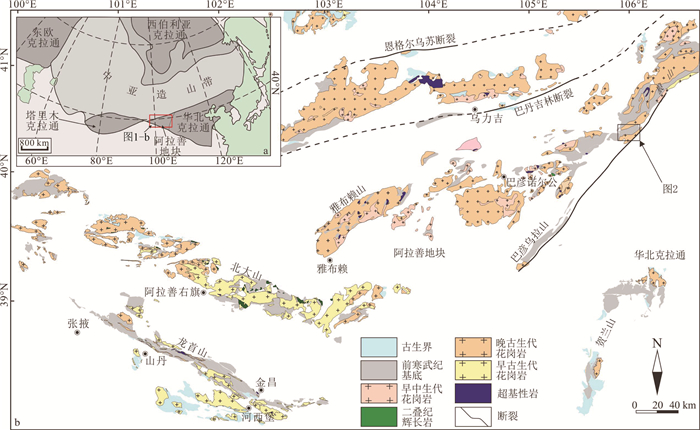
 下载:
下载:
